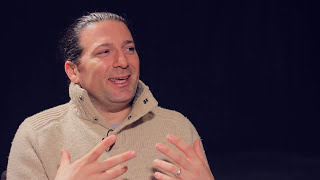In Chapter 12 of 21 in his 2012 Capture Your Flag interview, design educator Jon Kolko answers "How Are You Learning to Give More Impactful Presentations?" Kolko has built presentation confidence as his experience has grown and has learned to improve presentation content by using storytelling skills. Specifically, whether it is a presentation, a keynote, or a workshop, Kolko learns not to assume audience knowledge and to use narrative tools to take his room on a ride.
Jon Kolko is the founder and director of the Austin Center for Design. He has authored multiple books on design, including "Wicked Problems: Problems Worth Solving." Previously he has held senior roles at venture accelerator Thinktiv and frog design and was a professor of Interactive and Industrial Design at the Savannah College of Art and Design (SCAD). Kolko earned his Masters in Human Computer Interaction (MHI) and BFA in Design from Carnegie Mellon University.
Transcript:
Erik Michielsen: How are you learning to give more impactful presentations?
Jon Kolko: A lot of it has to do with doing it over and over and over. I don’t think I was like nervous of presenting but now I'm extremely confident with it. It's like anything else. It's like having a conversation. I actually don’t think too much about it but I think a lot about the content of the presentation and increasingly it seems like to reference an earlier question an argument, it seems like I'm structuring a narrative, a story if you'd like, around an endgame and the endgame is so clear to me but it doesn’t make any sense to anybody else if they don’t -- aren’t along for the journey. And so, in a typical presentation or a workshop or a keynote, it's an hour, 50 minutes. And so in 50 minutes, you got to take a couple hundred people along for this ride and there's nothing to assume. You have a wildly diverse audience. You can't assume knowledge about design, knowledge about politics, knowledge about the economy. And so, all those things have to be presented. And I think in many ways, it forces a huge amount of empathy with an audience as if they were the users of a product and you’re product. And so there has to be -- You sort of have to ease into it. I've never ever thought of myself as a good storyteller. Increasingly, I'm thinking of myself as a storyteller and that each time I craft this presentation, it's like a once upon a time. It's like a children’s novel. And everybody sort of comes along for the ride with me. There’s cute little things you can do that would be shocking, use really obtuse statistics to support your argument and juxtapose big words with scary images. And every now and then I’ll use those two just like anybody else. But I think ultimately like those are icing on a cake and if there's no cake, it's crap. And so, the substance of the thing, the content is that story.























